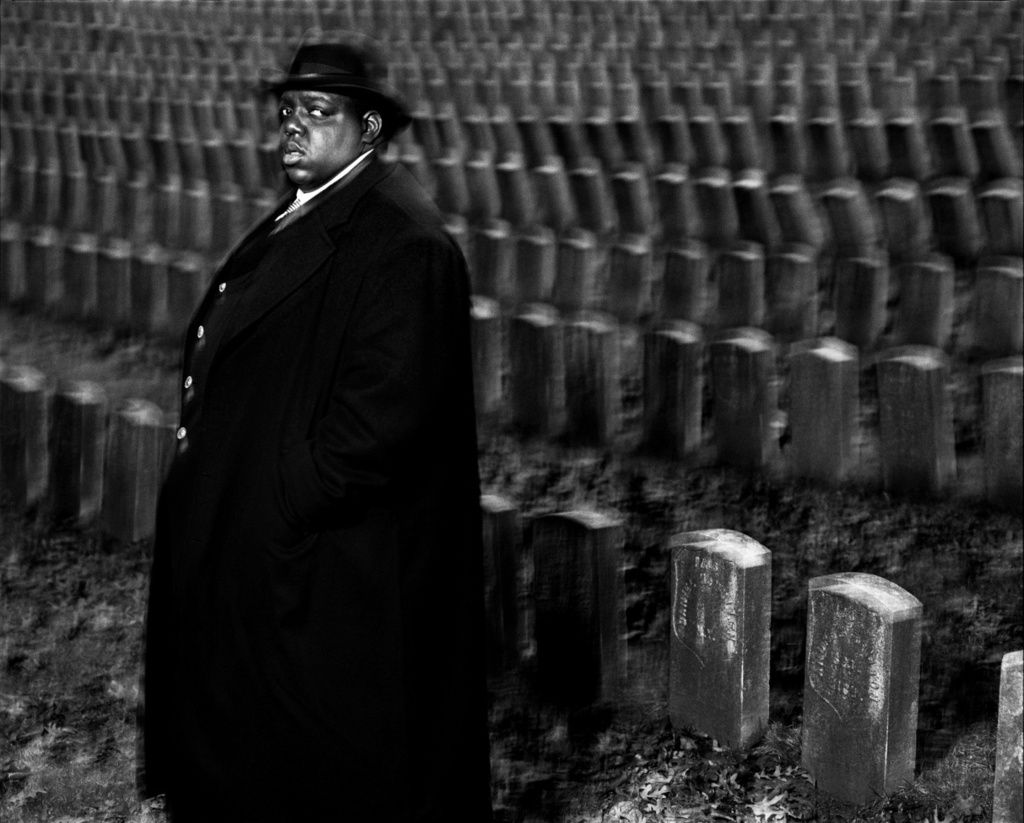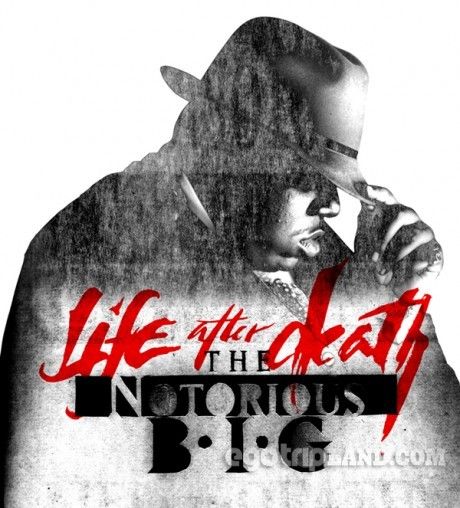Michael Lavine's best shot: Biggie Smalls in a graveyard
Jun 19, 2015 22:10:48 GMT
adman, feralthings, and 2 more like this
Post by Commissioner on Jun 19, 2015 22:10:48 GMT
‘I took this up a hill in in the Veterans Way area of the Cypress Hills cemetery. Biggie was dead six weeks later’

When I first met Biggie Smalls (aka the Notorious BIG), I thought, “He’s going to rip my head off,” but he was the nicest guy you would ever want to meet. So friendly, with the softest handshake.
In the early 90s, I was an indie-rock photographer. I worked with Nirvana, Sonic Youth and the Beastie Boys. But then I started getting hired by hip-hop artists – they wanted me because I made them look like rock stars. I’m a grunge guy, not a hip-hop guy, though, and I did not fit into their world.
Everyone wanted to be shot pointing a gun at the lens. I had to ask the art directors to pull the bullets out of them so they wouldn’t shoot me by accident.
I never saw Biggie with a gun though. I was hired to shoot his second album, Life After Death. The concept was very overt. The suit was made to look like an undertaker’s and they wanted him in a graveyard. It was in the middle of the east coast-west coast feud and a lot of people were getting shot. Tupac had already been killed. They were turning up the drama with this album.
The shoot took place at the Cypress Hills cemetery. Biggie was popular, but he wasn’t a legend yet. Still, it was the biggest job I’d ever had. I hired tonnes of speciality cameras and fancy lenses. The first shot we did became the album cover – Biggie standing in front of a hearse with the licence plate changed to B.I.G. When everything was in place, I asked my assistant to pass me my wide-angled lens. It wasn’t there. We searched everywhere, but the whole lot was gone: $15,000 of equipment. It must have been lifted while we were loading it into the van. I was nearly sick. I didn’t have time to think about what had happened, I just had to work through until the next break, when I sat in the graveyard on the phone to the insurance company.
I took this up a hill in in the Veterans Way area of the cemetery. It was a real effort getting Biggie up there. He had a huge entourage – multiple SUVs filled with bodyguards, pot smoke billowing out of the windows.
I was hired by his manager Puffy – which is what he called himself before he became P Diddy. The guy was a real mastermind – he was the brains behind Bad Boy Records and the whole east-coast hip-hop movement. But he was also a jerk, and really difficult to deal with.
At one point, we were looking for another location. The graveyard was so big, you had to drive around it. Puffy got in the front seat; Biggie got in the back. An Elvis song came on the CD: Suspicious Minds. Puffy went off: “What the hell is this crap?!” Then Biggie’s voice came from the back: “Man … chill out. Elvis was cool.”
We curved up the hill and parked and Biggie got out of the car with his cane and hobbled to the edge of the tombstones. He had a lot of physical ailments – he walked slow and heavy, and had this wandering left eye, which really infects this image.
I wanted the whole shot lined up with tombstones; no other distractions. The way that he is turned away from them is a symbol of defiance – a powerful stance that says: “You can’t touch me.”
Biggie died six weeks later. He was gunned down in Los Angeles. Nobody ever proved who shot him.
All these years later it’s still the most powerful image I have. The image of a young black man in a graveyard is politically very powerful. It was a news story every day then, and it still is now.
CV
Born: San Francisco, 1963.
Studied: Parsons School of Design, New York.
Influences: Philippe Halsman, Robert Frank, Garry Winogrand, Diane Arbus.
Career high: “I just shot the campaign for the show Empire. It’s the biggest TV show ever.”
Career low: “The time I got arrested and missed my shoot with Deee-Lite for Interview magazine.”
Top tip: “Never give up, never lose your cool.”

An early comp from the album cover development process.

When I first met Biggie Smalls (aka the Notorious BIG), I thought, “He’s going to rip my head off,” but he was the nicest guy you would ever want to meet. So friendly, with the softest handshake.
In the early 90s, I was an indie-rock photographer. I worked with Nirvana, Sonic Youth and the Beastie Boys. But then I started getting hired by hip-hop artists – they wanted me because I made them look like rock stars. I’m a grunge guy, not a hip-hop guy, though, and I did not fit into their world.
Everyone wanted to be shot pointing a gun at the lens. I had to ask the art directors to pull the bullets out of them so they wouldn’t shoot me by accident.
I never saw Biggie with a gun though. I was hired to shoot his second album, Life After Death. The concept was very overt. The suit was made to look like an undertaker’s and they wanted him in a graveyard. It was in the middle of the east coast-west coast feud and a lot of people were getting shot. Tupac had already been killed. They were turning up the drama with this album.
The shoot took place at the Cypress Hills cemetery. Biggie was popular, but he wasn’t a legend yet. Still, it was the biggest job I’d ever had. I hired tonnes of speciality cameras and fancy lenses. The first shot we did became the album cover – Biggie standing in front of a hearse with the licence plate changed to B.I.G. When everything was in place, I asked my assistant to pass me my wide-angled lens. It wasn’t there. We searched everywhere, but the whole lot was gone: $15,000 of equipment. It must have been lifted while we were loading it into the van. I was nearly sick. I didn’t have time to think about what had happened, I just had to work through until the next break, when I sat in the graveyard on the phone to the insurance company.
I took this up a hill in in the Veterans Way area of the cemetery. It was a real effort getting Biggie up there. He had a huge entourage – multiple SUVs filled with bodyguards, pot smoke billowing out of the windows.
I was hired by his manager Puffy – which is what he called himself before he became P Diddy. The guy was a real mastermind – he was the brains behind Bad Boy Records and the whole east-coast hip-hop movement. But he was also a jerk, and really difficult to deal with.
At one point, we were looking for another location. The graveyard was so big, you had to drive around it. Puffy got in the front seat; Biggie got in the back. An Elvis song came on the CD: Suspicious Minds. Puffy went off: “What the hell is this crap?!” Then Biggie’s voice came from the back: “Man … chill out. Elvis was cool.”
We curved up the hill and parked and Biggie got out of the car with his cane and hobbled to the edge of the tombstones. He had a lot of physical ailments – he walked slow and heavy, and had this wandering left eye, which really infects this image.
I wanted the whole shot lined up with tombstones; no other distractions. The way that he is turned away from them is a symbol of defiance – a powerful stance that says: “You can’t touch me.”
Biggie died six weeks later. He was gunned down in Los Angeles. Nobody ever proved who shot him.
All these years later it’s still the most powerful image I have. The image of a young black man in a graveyard is politically very powerful. It was a news story every day then, and it still is now.
CV
Born: San Francisco, 1963.
Studied: Parsons School of Design, New York.
Influences: Philippe Halsman, Robert Frank, Garry Winogrand, Diane Arbus.
Career high: “I just shot the campaign for the show Empire. It’s the biggest TV show ever.”
Career low: “The time I got arrested and missed my shoot with Deee-Lite for Interview magazine.”
Top tip: “Never give up, never lose your cool.”

An early comp from the album cover development process.



